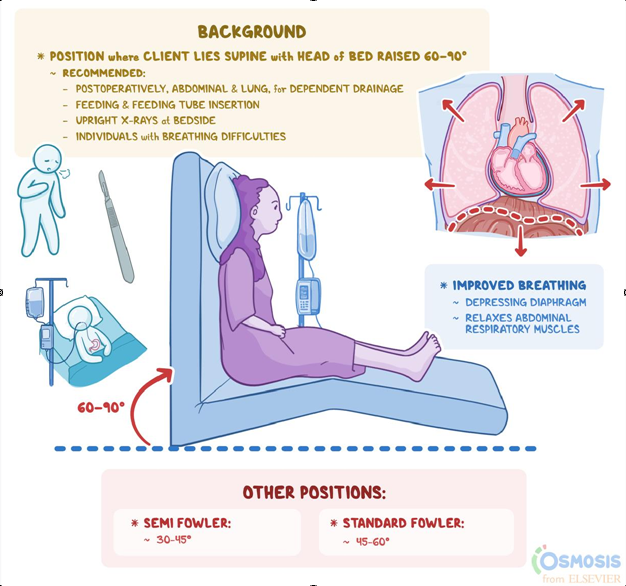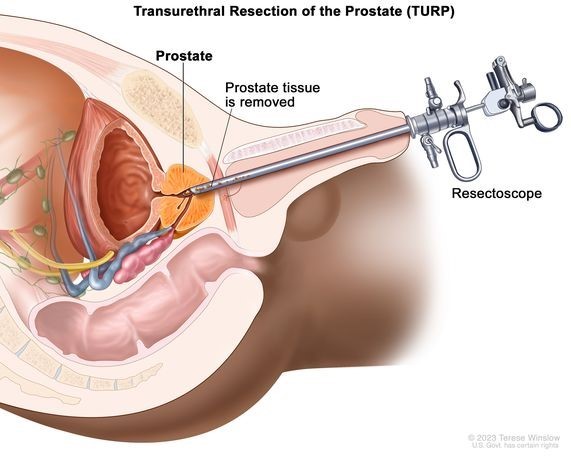A nurse is collecting data from a client who has heart failure. The nurse notes the client has crackles in the bases of the lungs, shortness of breath, and a respiratory rate of 24/min.
Which of the following actions should the nurse take?
Instruct the client to cough every 4 hr.
Encourage the client to ambulate to loosen secretions.
Increase the client's intake of oral fluids.
Maintain the client in high-Fowler's position.
The Correct Answer is D
Explanation
D. Maintain the client in high-Flower’s position
Crackles in the bases of the lungs, shortness of breath, and an increased respiratory rate are signs of pulmonary congestion, which is commonly seen in heart failure. Maintaining the client in a high-Fowler's position, with the head of the bed elevated to a 45-60-degree angle, helps reduce venous return to the heart, decreases fluid accumulation in the lungs, and improves breathing comfort for the client.
The other options are not appropriate actions for the client's condition:
Instructing the client to cough every 4 hours in (option A) is not the priority action in this situation. Coughing may not effectively address the underlying cause of pulmonary congestion and may not provide immediate relief for the client.
Encouraging the client to ambulate to loosen secretions in (option B) is not the priority action in this situation. While ambulation can be beneficial for overall health, the client's symptoms of pulmonary congestion require immediate attention to improve respiratory status.
Increasing the client's intake of oral fluids in (option C) is not the priority action in this situation. While maintaining adequate hydration is important, excessive fluid intake can worsen the symptoms of heart failure and contribute to further fluid accumulation in the lungs.
Therefore, the nurse should maintain the client in high-Fowler's position (option D) to promote optimal lung function and improve breathing comfort. It is important to promptly notify the healthcare provider of the client's condition for further assessment and intervention.

Nursing Test Bank
Naxlex Comprehensive Predictor Exams
Related Questions
Correct Answer is A
Explanation
Dark red urine following a transurethral resection of the prostate (TURP) can indicate active bleeding or hematoma formation. It is important to notify the provider because further assessment and intervention may be necessary to address the source of the bleeding and prevent complications.
Frequent urge to urinate is expected after a TURP procedure as the bladder recovers and adapts to the changes. This is not a concerning finding and does not require immediate reporting to the provider.
Urine output of 300 mL over 8 hours can be considered adequate, especially in the early postoperative period. The nurse should continue to monitor the client's urinary output, but this finding does not require immediate reporting.
Occasional small clots in the urine can be expected after a TURP procedure due to the healing process and sloughing of tissue. However, if the clots become large or obstructive, or if there is a sudden increase in the frequency of clots, it should be reported to the provider.

Correct Answer is D
Explanation
Explanation:
Avoid pregnancy for at least 28 days after receiving the vaccine: This is a crucial instruction for women of childbearing age. The MMR vaccine is a live attenuated vaccine, and women should avoid becoming pregnant for at least 28 days after receiving it to reduce the theoretical risk to the developing fetus. Pregnant women should not receive the MMR vaccine, and women who receive the vaccine should avoid getting pregnant for at least 28 days afterward.
Incorrect:
A- Avoid breastfeeding for 3 days after receiving the vaccine: This statement is not accurate. Breastfeeding is not contraindicated after receiving the MMR vaccine. In fact, breastfeeding is safe and can be continued as usual.
B- Your partner should also receive the MMR vaccine: While it is essential for individuals to be vaccinated against measles, mumps, and rubella for their own protection and to contribute to herd immunity, it is not a specific instruction given to the postpartum client.
C- If you are allergic to gluten, you should not receive this vaccine: The MMR vaccine does not contain gluten, and a gluten allergy is not a contraindication for receiving the vaccine.
Whether you are a student looking to ace your exams or a practicing nurse seeking to enhance your expertise , our nursing education contents will empower you with the confidence and competence to make a difference in the lives of patients and become a respected leader in the healthcare field.
Visit Naxlex, invest in your future and unlock endless possibilities with our unparalleled nursing education contents today
Report Wrong Answer on the Current Question
Do you disagree with the answer? If yes, what is your expected answer? Explain.
Kindly be descriptive with the issue you are facing.
